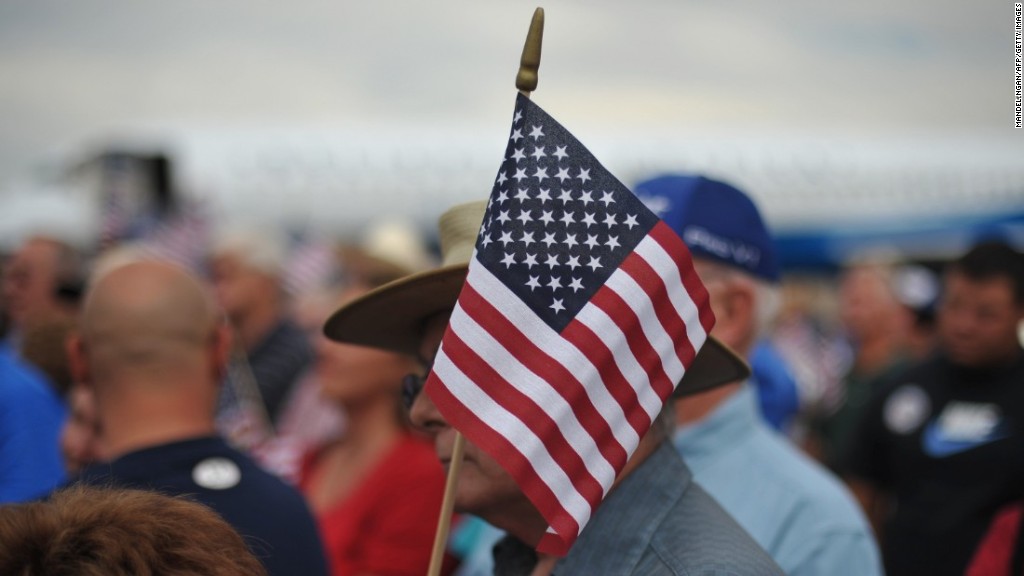
All his life, Chris Olah was told you can't trust the government.
His grandfather and his father drilled it into his head that you have to rely on yourself and can't expect the government to bail you out.
Olah, 43, still believes the federal government is to blame for many of the problems affecting working class Americans like himself. Yet, the Frenchville, Pennsylvania, resident would like Washington D.C. to do more to help people like him who have fallen on hard times. He's struggling to find work despite having just earned an associate's degree in criminal justice.
"The government is not putting enough emphasis on keeping jobs in America for American people," said Olah, who assembled Ford trucks in Virginia for 13 years before the company consolidated truck production closer to Detroit. "We should get more help for educated people to go to work."
Many in the white working class share Olah's sentiments, according to a new CNN/Kaiser Family Foundation poll. Some 62% of white working class Americans said the federal government bears all or most of the blame for the economic troubles facing the working class. Yet, two-thirds also feel that the federal government doesn't do enough to help working class folks.
Related: The 'forgotten tribe' in West Virginia
Working class whites with lower incomes are more than twice as likely as their higher-earning peers to want more government assistance.
While there's no set definition of the working class, CNN/KFF considers this group to include those without four-year college degrees for this poll.
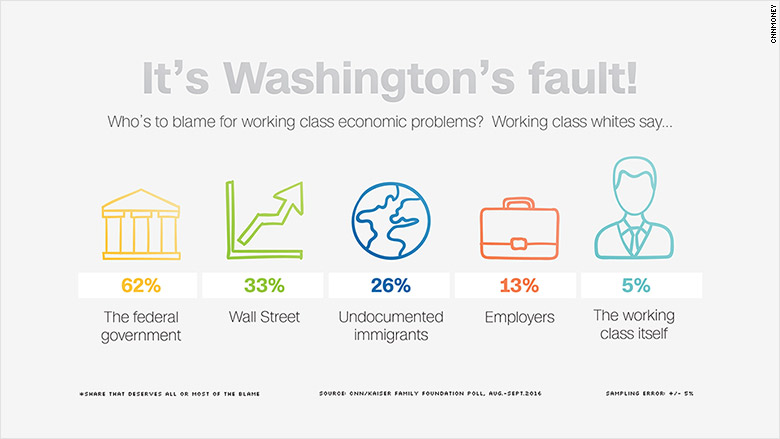
Among college-educated whites and working class blacks and Hispanics, the share that blame the government is less than half. And when it comes to whether the feds could do more to help the working class, 54% of educated whites agreed, while more than two-thirds of working class blacks and Hispanics stand with their white peers that the government could provide more assistance.
However, some in the white working class want the federal government to do more for them specifically. Just over a third think Washington already does too much for racial and ethnic minorities, and 63% think it does too much for the wealthy.
Related: White Working Class & Worried
Where Olah lives, in rural Clearfield County, Pennsylvania, only 11.1% of white, non-Hispanic residents age 25 and older hold bachelor's degrees -- the lowest share among larger counties in the U.S. And, 93% of the county's roughly 80,000 residents are white, non-Hispanics, according to U.S. Census Bureau statistics.
Olah moved to Clearfield in 2007 to be closer to his now ex-wife's family and worked as a mechanic for several years. After being laid off, he enrolled in York Career Institute. He just graduated last month. He has applied to the jails in the area, as well as at a Walmart distribution center, but he has yet to land anything.
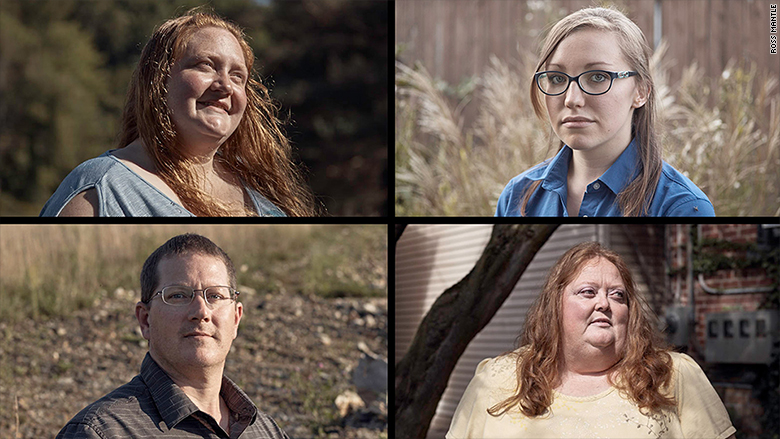
He went back to school because he thought it was the only way to find a decent-paying job to support his two teen children. Now, he's saddled with $22,000 in student loans. To get by, Olah and his kids receive $311 in food stamps and $264 in cash assistance each month, as well as public health coverage and a home energy subsidy.
Still, Olah believes politicians and government workers at all levels are ineffective at best and corrupt at worst. They still get paid, he stresses, although nothing gets done to help struggling Americans like him. He'd like to see the federal government make college more affordable, revamp safety net programs to assist more people with low-wage jobs and provide more incentives for companies to create jobs.
Some 34% of working class whites polled by CNN/KFF said someone in their household received government benefits in the past year (excluding Social Security and Medicare). That compares to 21% of college-educated whites, 61% of working class blacks and 48% of working class Hispanics. The most common benefits included Medicaid (19%), disability (12%) and food stamps (11%).
Those already receiving public assistance are more likely than those who don't get aid to say the government doesn't do enough to help people like them, by a 63% to 47% split.
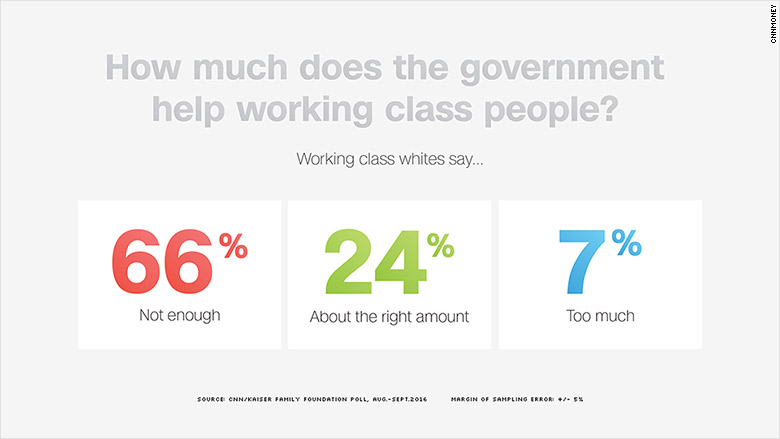
Getting more aid to pay for higher education was a popular request among the Clearfield residents CNNMoney interviewed. Good paying positions that require only a high school diploma -- in the coal mines, brickyards and sewing factories -- have long since disappeared, and minimum-wage jobs in fast food or retail don't cover the bills, locals said. It wouldn't be hard for them to enroll as there are five colleges and technical schools in the county, including a branch of Pennsylvania State University.
Related: The men America has left behind
"You can't get by without a degree," said Shyanne Lowe, 22, a married mother of two who just started studying for an associate's degree in nursing at the Clearfield branch of Lock Haven University. "We tried the working class lifestyle and you can't get ahead."
Lowe, who also works part-time at the front desk of a local hotel, said the federal government is going deeper into debt giving pay raises to politicians and aid to other countries. Meanwhile, Americans pay high taxes but don't get free college, health care and other benefits that citizens in other nations receive.
Instead, the government should provide more assistance to those trying to move up the economic ladder, said Lowe, whose husband is studying for his bachelor's degree in economics at Penn State and works part-time at a furniture and appliances store. She would like to see the feds lower tuition, offer paid maternity and paternity leave and make subsidized day care more widely available.
Right now, the Lowes are paying most of their bills by taking out student loans, which they expect to climb into the six figures by the time they are done with school. They also receive food stamps, public health coverage and WIC assistance for women, infants and children. They are on a waiting list for subsidized day care, which currently costs them $900 a month for their two-year-old son and infant daughter.
"There's no way we'd advance if we didn't do it this way," said Lowe, who lives in Clearfield borough.
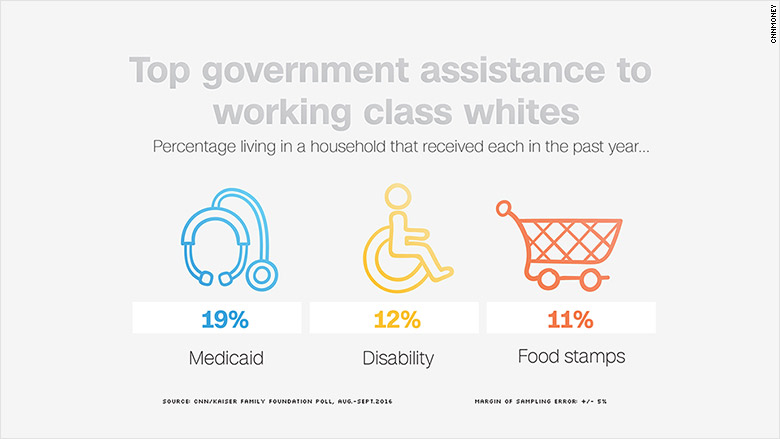
It didn't used to be like this in Clearfield County, which lies within the tree-covered rolling hills just off Interstate-80. Like in other parts of the U.S., high school graduates used to be able to make a comfortable living. The disappearance of those opportunities has fueled resentment among the working class.
Robin Holt, 57, sees the struggles firsthand as a staffer at Central PA Community Action, a non-profit social services agency in Clearfield. Its clientele includes unemployed middle-aged men living in shelters with few job prospects. The federal government has good programs to help the needy, she said, but it must fund them better and make them more effective.
Related: These Americans are fighting to bring manufacturing jobs back
Holt, who also owns two rental properties and a laundromat, wonders why the feds bailed out the banks during the Great Recession instead of doing more to directly help Americans. The banks only made it harder for people to take out loans, said the West Decatur, Pennsylvania, resident.
"If they gave everyone $100,000, that would have kick-started a lot of people," she said.
Holt is saddled with $15,000 in student loans that got her halfway through a bachelor's degree in business management from Lock Haven University several years ago. She doesn't know whether it's worth the money to finish since well-paying jobs are hard to find in Clearfield these days. She makes $10.45 an hour now, compared to $12 an hour in the 1980s when she worked at a local sewing factory.
Over and over again, those interviewed in Clearfield voiced disdain for government at all levels: Elected officials make promises they don't keep and don't get anything done. Bureaucrats just collect a paycheck and don't try to help those in need.
That's why Heather Grimm, 33, doesn't bother voting. The single mother lives with her two young boys and fiancee, Jesse Harnish, in subsidized housing, which eats up about 40% of his monthly income from driving school and charter buses. She thinks politicians are greedy and the system is broken.
Related: The anatomy of a white working class Trump voter
Grimm, who worked from the age of 16 until nearly four years ago, said jobs in the area don't pay enough for her to buy a car and to put her kids in after-school programs. And if she were employed, she'd also lose her food stamps and other public assistance.
The Clearfield borough, Pennsylvania, resident thinks the deck is stacked against working class folks like her.
"The government makes the rules for us to follow," said Grimm. "But people get fed up. We are doing what we are supposed to be doing, but we're not getting anywhere."
White, Working Class & Worried is a CNN partnership with the Kaiser Family Foundation - an extensive survey of white, working class Americans and voters who form a backbone of the support for Donald Trump. See more tonight on Anderson Cooper 360.
About the survey: CNN partnered with The Kaiser Family Foundation to conduct an in-depth survey of the white working class in America, their politics, their perceptions of America's changing demographics, the economy, immigration, their personal finances, their faith, among others. This group has become increasingly important to the 2016 presidential race since they have been a key support to Donald Trump's bid for the White House. Here are the full results of the survey.



